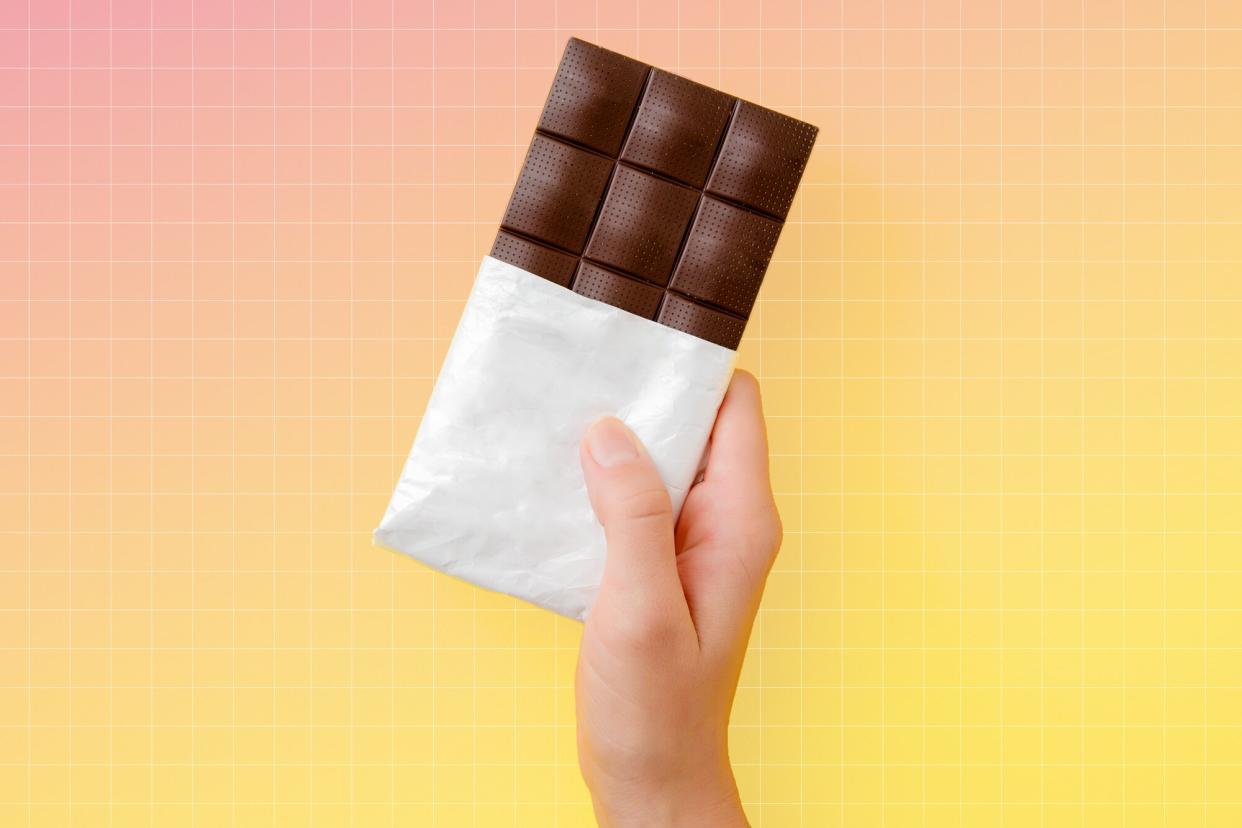What's that white coating on my chocolate — and is it safe to eat?

Getty Images
It's happened to just about all of us—you open up a bar of chocolate for a treat, a bag of chocolate chips to make cookies, or a tin of homemade chocolate bark, and discover that the chocolate has a weird-looking white coating. What is that stuff? And is your chocolate still safe to eat?
The white coating that forms on the surface of chocolate is called bloom, and—here's the good news—it's perfectly safe to eat. "Though the appearance of bloom looks unappetizing—some may even mistake it for a type of mold—the chocolate is absolutely safe to consume," says Michael Laiskonis, creative director at the Institute of Culinary Education who also oversees the school's Chocolate Lab, which does bean-to-bar production of chocolate.
There are two types of chocolate bloom—sugar bloom and fat bloom. While both are safe to eat, they affect the appearance, texture and "flavor release" of the chocolate, and can strip it of "some of its most pleasing qualities as it melts in the mouth," says Laiskonis. Read on for everything you need to know about both kinds of chocolate bloom, including what causes them, how to prevent them, how they affect the taste and texture of chocolate, and how best to use bloomed chocolate.
Sugar Bloom
"Sugar bloom happens when the sugar in chocolate separates from the other ingredients," explains Megan Giller, who wrote the book Bean-to-Bar Chocolate and who runs chocolate tastings through her company Chocolate Noise. Giller explains that sugar bloom, which gives chocolate a dusty look, is caused by the chocolate coming into contact with moisture—this can happen if it gets wet during shipping or is stored in a damp place in your house. Sugar-bloomed chocolate can have a noticeably grainy texture, says Laiskonis, "as some of the finely ground sugar crystals have dissolved and then recrystallized into larger particles."
Fat Bloom
"Cocoa beans are naturally about 50% fat, and that fat is called cocoa butter," says Giller. "When it separates from the rest of the ingredients, the result is fat bloom." There are a variety of causes of fat bloom in chocolate, including poor tempering when the chocolate is being made, faulty storage and changes in temperature, Giller says. Chocolate with fat bloom will look powdery gray, white or tan, she adds, and it'll have a soft, crumbly texture.
How to Prevent Chocolate Bloom
The best way to keep chocolate from blooming is to store it at a steady, moderate temperature away from moisture. Of course you can't control how the chocolate was stored or treated before it reaches you, but once you get it home keep it in a cool, dry place in an airtight container. The ideal temperature for storing chocolate is between 65° and 68°F, according to Lake Champlain Chocolates. If it is warmer than 70° in your home, you can move the chocolate to the fridge, but be sure to wrap it very well to prevent the fridge's moisture from causing the sugar to bloom. And if you store chocolate in the freezer, transfer it to the fridge to thaw, then bring it to room temperature before eating it or using it in recipes to avoid rapid temperature and humidity changes. And while chocolate can maintain its quality for a long time at room temperature—up to two years, according to Lake Champlain Chocolates—using it sooner rather than later will lessen the chances of it being exposed to temperature and humidity changes.
What to Do with Bloomed Chocolate
As mentioned above, it's safe to eat bloomed chocolate, so don't chuck it in the trash bin. "Throwing away bloomed chocolate is the one of the main mistakes I see people make," says Giller. "With both types of bloom, the texture will be markedly different than with tempered chocolate, but the flavor won't change." You can eat bloomed chocolate as-is, but since the texture of bloomed chocolate is usually a bit chalky, grainy, crumbly and dry, consider using it in recipes where it'll be melted. (You can also retemper fat-bloomed chocolate, but fixing sugar-bloomed chocolate is impossible without chocolate-making equipment, says Laiskonis.)
"Either form of bloomed chocolate is perfectly fine to use in a range of recipes to no ill effect, especially when melted or combined with a liquid (like in ganache or chocolate sauce, for example)," Laiskonis says. "Fat bloom is largely superficial, and in baking applications, the slight grainy texture of sugar-bloomed chocolate would likely not be detectable." Along with chocolate sauces and ganache, Laiskonis says bloomed chocolate is ideal for mousses and creams, "where the larger cocoa butter fats are realigned and any sugar crystals created by sugar bloom will be dissolved."
Giller concurs that bloomed chocolate is great for using in recipes. "There are so many ways to use bloomed chocolate!" she says. "I use it all the time in recipes where the chocolate needs to be melted. I constantly make chocolate chip cookies and chocolate cakes with fat-bloomed chocolate, and it's ideal for drinking chocolate too."
You can also use bloomed chocolate to make a nut bark or brownies. Or just melt it with a little milk in the microwave and stir it together for a thick, rich hot chocolate. However you use it, it'll surely be more satisfying than if you were to throw it in the trash.






